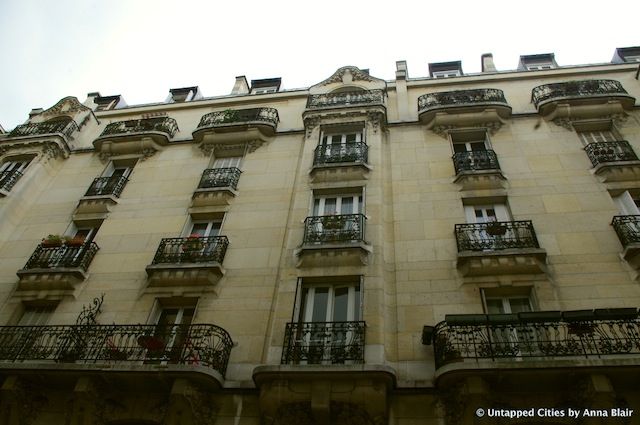100th Anniversary Great Nave Tour at the Cathedral of St. John the Divine
Celebrate the 1925 construction of the stunning nave inside the world's largest Gothic cathedral!

The 17th arrondissement is largely residential and often overlooked due to its lack of obvious attractions. This only serves to make it a more pleasant place for strolling, far from extreme traffic and footpaths crowded with tourists carrying backpacks on their stomaches. Paris’s north-west is peppered with more subtle pleasures than its centre, but with pleasures nonetheless.

I would advise you to begin around Avenue de Clichy, perhaps with the Cité des Fleurs. This area of Paris isn’t exceptional architecturally, but it is quite different from other parts of Paris. There are more townhouses and less of the typical seven storey buildings, because Haussmann didn’t really bother with the 17th. When this area became part of Paris, areas of land were sold to developers who had fairly free reign with what they built on them. The Cité des Fleurs is best known for the fact that the inhabitants have gardens. These are mostly hidden behind high fences, but the street nonetheless has a nice vibe to it.
The area just south, Les Batignolles, tends to pop up in discussions of ‘Paris’s remaining villages’. It does feel a little like a village, self-contained and easy on pedestrians, but it also feels a lot like Melbourne, where I grew up. I tend to think of Les Batignolles as a miniature Parisian Melbourne, complete with stylish cafes where one can spend a lot of money on organic brunches. I would advise beginning with lemonade and caviar d’aubergine at the Lebanese food stand in the market before strolling through the little park where elderly men play boules beside the railway line (and if you think this sounds more like France than Australia, you haven’t played lawn bowls in Windsor) and then across to the southern half of the arrondissement.

Right at the edge of Paris is Edouard Francois’s ‘Flower Tower’, a social housing project completed in 2004. The tower aims to extend the garden it sits beside vertically, and the plants on the balconies both allow residents aspects of a garden in a small space and create a screen for privacy. It’s always credited as the building which made Francois an important figure in the green architecture movement.

At the junction of Avenue Wagram and Rue Brémontier is a building by Pierre Patout. It’s now a hotel, owned by the Best Western chain. The exterior has been well maintained, and changes (such as the pink colour, which I don’t think is original, and the sign) seem in keeping with the spirit of the 1930s. The lobby, too, has art deco furnishings and the door to the lift is amazing. It’s probably not a place to recommend to all your friends, as staying in the cheapest room for a weekend costs more than a month’s rent for a sixth arrondissement studio.

Those who like stories behind buildings may be interested in 80 Rue Jouffroy d’Abbans. It’s nothing spectacular from the outside -though perhaps a good example of a late nineteenth century townhouse created outside the perimeters of Haussmann’s rules- but once was home to Virginie Amélie Gautreau, a Parisian socialite best known as the subject of John Singer Sargent’s ‘Madame X’. Sargent had his studio in the 17th, too, though I’m not sure of the exact address and have read that the building is no longer standing.

A little further south, just off the charming market street of Rue Poncelet, is an apartment building by Henri Sauvage and Charles Sazzarin from 1904. If you’re familiar with their later work (best known are the buildings on Rue des Amiraux and Rue Vavin, flats designed to promote healthy lifestyles, and Sauvage’s facade for La Samaritaine), you’ll probably be quite surprised by the typical art nouveau character of this early building. I tried to find signs of their later architectural concerns, but they’re not obvious. It’s a nice building, nonetheless, finely decorated without being overdone.

From many places, you can see the tower of Saint Odile. This church was designed by Jacques Barge and built from 1935 to 1946, one of a number of modern churches built under the “Chantiers du Cardinal” program. These churches were designed to serve the population of Paris, which had expanded rapidly in the nineteenth and early twentieth century. In designing Saint Odile, Barge looked to Byzantine architecture for inspiration, with three internal domes inspired by the Hagia Sophia in Istanbul.
The bell-tower pops up regularly as one looks west, as during this period the Catholic Church sought (more broadly) to make its presence felt in a world that was forgetting religion. This concrete tower has an element of Auguste Perret about it (as did many church towers at this point), but is stylishly streamlined. While it might not have drawn the people of the 17th back to religion, it’s something of a beacon to architectural pilgrims.
This post was originally published on the blog Flappers with Suitcases. Get in touch with the author at @annakblair.
Subscribe to our newsletter